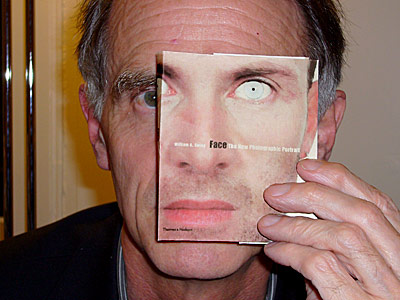Facing up to the new photographic portrait

William Ewing, director of Lausanne's Musée de l'Elysée photography museum, tells swissinfo why the human face has formed the centrepiece of his new book.
The Canadian says that the art of photographic portraiture – and his own museum – is currently at a turning point, as methods and perceptions change.
The book, entitled “Face – the new photographic portrait”, contains 240 pictures from 113 international photographers. There are five editions in three languages.
“Face” is mainly the result of work carried out for three exhibitions – in Lausanne, Lisbon and London – organised by the Musée de l’Elysée.
Photographers use a variety of techniques, including computer manipulation, retouching, photomontage and other methods of veiling and disguising to present their versions of the face.
Ewing says that photo portraiture has undergone three phases: close likenesses, the face as the window on the soul and the start of a new era of discovery in photography.
swissinfo: You have said that we are currently reliving the early days of photography. What do you mean by this?
William Ewing: This is certainly due to a combination of circumstances. Computers have made more changes possible. There have also been new perceptions about what a face is – think if the first face transplant last year or genetic engineering which allows a baby’s face to be chosen from a catalogue.
Photographers therefore now approach the face in a different way. It’s all the ways the face can be reinvented and remodelled that best explain the fear expressed in this book. It’s a commentary on the fact that the contours of the face, which always seemed to be fixed, have become something fluid and changeable.
Technology has always opened doors. Digital cameras have ushered in an extraordinary flexibility. It’s not necessarily better, but it’s different. The young generation sees a whole set of new possibilities there and the face is at the top of their priorities.
swissinfo: A number of photographers use multiple images or mix portraits to make more than one.
W.E.: For about one-and-a-half centuries people believed that a photo could capture the soul, reveal the truth. Our idea of the human has changed. Everybody knows how a single photo can cheat. From now on a photo will be a variant, a possibility, but you will want to see a second, a third, in a sort of movement.
swissinfo: The book contains works by 14 Swiss. Which of them best represents this new approach to portraiture?
W.E.: Daniele Buetti and Pierre Fantys, but also young people at the start of their careers such as Mona Schweizer or Eva Lauterlein. Lauterlein mixes analogue and digital photography. She takes up to 30 portraits of a single person, works on them and mixes them on the computer. These portraits seem strange; they have something both human and inhuman about them.
It’s a fascinating area of photography. When the image is too real, too everyday, it’s no longer interesting. When it’s pure fiction, you don’t believe it. It’s the area between the two which is of interest to many photographers.
swissinfo: What place does the Musée de l’Elysée have in the photography world?
W.E.: In 2005 we marked the museum’s 20th anniversary with the “reGeneration” exhibition on photographers of the future. It went via China to Boston and will go to Russia, Florida and California. My idea was to follow the young photographers gathered for this event to broaden the museum’s vision.
Digitalisation had led to very exciting times in photography and reGeneration has helped understand this. The next stage is in February with an exhibition entitled “We are all photographers”. It will be playful but also serious because the number of photos taken by mobile phones is upsetting the order of things.
These exhibitions are a way of discerning the future and reconsidering the problems linked to our collections. You can now store 20,000 images on mobile phones! Everyone can therefore take almost the whole history of photography around with them. Everyone can become a museum.
A museum has to take this into consideration as well as reflect on ways of sharing its images… I’m sure that it’s through big events like reGeneration that we’ll find new paths for the museum.
swissinfo-interview: Bernard Léchot
Face – the new photographic portrait is by William Ewing in collaboration with Nathalie Herschdorfer.
It includes pictures from such well-known photographers as Valérie Belin, Philip-Lorca diCorcia, Lee Friedlander, Barbara Kruger, Orlan, Martin Parr, Cindy Sherman as well as 14 Swiss photographers.
The Canadian William Ewing has been director of the Musée de l’Elysée in Lausanne since 1995 and also teaches at Geneva University.
He studied anthropology before opening the Optica photo gallery and founding the Musée d’art contemporain in Montreal, Canada. He has also managed exhibitions at the International Center of Photography in New York and been an independent curator in London.
Ewing has published more than a dozen books on diverse aspects of photography.

In compliance with the JTI standards
More: SWI swissinfo.ch certified by the Journalism Trust Initiative










You can find an overview of ongoing debates with our journalists here . Please join us!
If you want to start a conversation about a topic raised in this article or want to report factual errors, email us at english@swissinfo.ch.